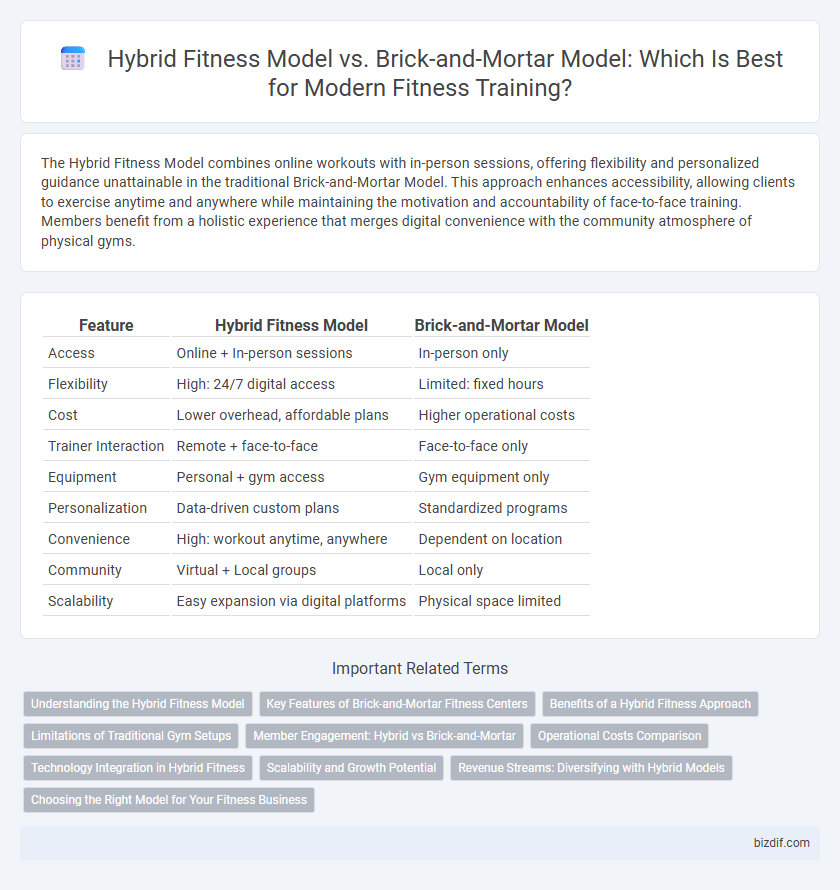The Hybrid Fitness Model combines online workouts with in-person sessions, offering flexibility and personalized guidance unattainable in the traditional Brick-and-Mortar Model. This approach enhances accessibility, allowing clients to exercise anytime and anywhere while maintaining the motivation and accountability of face-to-face training. Members benefit from a holistic experience that merges digital convenience with the community atmosphere of physical gyms.
Table of Comparison
| Feature | Hybrid Fitness Model | Brick-and-Mortar Model |
|---|---|---|
| Access | Online + In-person sessions | In-person only |
| Flexibility | High: 24/7 digital access | Limited: fixed hours |
| Cost | Lower overhead, affordable plans | Higher operational costs |
| Trainer Interaction | Remote + face-to-face | Face-to-face only |
| Equipment | Personal + gym access | Gym equipment only |
| Personalization | Data-driven custom plans | Standardized programs |
| Convenience | High: workout anytime, anywhere | Dependent on location |
| Community | Virtual + Local groups | Local only |
| Scalability | Easy expansion via digital platforms | Physical space limited |
Understanding the Hybrid Fitness Model
The Hybrid Fitness Model combines online virtual workouts with traditional in-person training sessions, offering greater flexibility and personalized fitness experiences. This model leverages digital platforms for on-demand classes, progress tracking, and real-time coaching, enhancing engagement and accessibility. Fitness businesses adopting the hybrid approach can efficiently scale their services while maintaining direct client interaction and motivation.
Key Features of Brick-and-Mortar Fitness Centers
Brick-and-mortar fitness centers offer physical locations equipped with a wide range of exercise machines, free weights, and specialized studios for classes such as yoga and spinning. These centers provide in-person coaching, group workout sessions, and immediate access to fitness professionals, fostering community engagement and personalized motivation. On-site amenities often include locker rooms, showers, and recovery zones, enhancing the overall user experience compared to hybrid models.
Benefits of a Hybrid Fitness Approach
A hybrid fitness model combines in-person training with digital workouts, offering greater flexibility and personalized guidance for diverse fitness goals. This approach enhances client engagement by providing access to professional trainers both onsite and remotely, accommodating varied schedules and locations. The hybrid model also supports consistent progress tracking through integrated technology, leading to improved adherence and better overall fitness outcomes.
Limitations of Traditional Gym Setups
Traditional gym setups often face limitations such as restricted operating hours, limited class diversity, and high overhead costs that can reduce accessibility and flexibility for members. The physical constraint of location binds users to specific times and places, limiting workouts for those with busy schedules. Equipment maintenance and space limitations further hinder the ability to offer personalized, varied training programs compared to hybrid fitness models integrating digital platforms.
Member Engagement: Hybrid vs Brick-and-Mortar
Member engagement in the hybrid fitness model leverages digital platforms and in-person sessions, providing flexible access and personalized experiences that increase retention rates by up to 30%. Brick-and-mortar gyms rely heavily on physical presence, which can limit engagement during off-hours or inclement weather and often results in lower overall participation. The hybrid approach utilizes real-time data tracking and virtual communities to foster continuous motivation, enhancing member interaction compared to traditional models.
Operational Costs Comparison
The Hybrid Fitness Model significantly reduces operational costs by combining in-person sessions with virtual training platforms, minimizing expenses related to physical space and utilities. Brick-and-Mortar gyms incur higher fixed costs such as rent, maintenance, and staff salaries to maintain large facilities and equipment. Leveraging digital infrastructure, the Hybrid model optimizes resource allocation, resulting in improved profitability and scalability in the fitness industry.
Technology Integration in Hybrid Fitness
Hybrid fitness models leverage advanced technology integration such as virtual workout platforms, wearable devices, and AI-driven personalized coaching to enhance user engagement and track progress in real-time. These digital tools enable seamless connectivity between trainers and clients, offering flexible, data-driven fitness solutions beyond the limitations of traditional brick-and-mortar gyms. The synthesis of in-person and online training environments creates a comprehensive fitness experience optimized for convenience, customization, and measurable results.
Scalability and Growth Potential
The Hybrid Fitness Model integrates both online and in-person training, offering scalable options to reach a broader audience beyond geographical limits, unlike the traditional Brick-and-Mortar Model confined to physical locations. Digital platforms enable continuous client engagement and personalized programming, accelerating growth potential through subscription-based revenue streams and flexible service delivery. Consequently, fitness businesses adopting a hybrid approach can expand market presence and increase profitability more effectively than standalone brick-and-mortar gyms.
Revenue Streams: Diversifying with Hybrid Models
Hybrid fitness models integrate online platforms with traditional gym facilities, creating multiple revenue streams such as digital memberships, virtual classes, in-person training, and merchandise sales. This diversification attracts a broader audience by offering flexible workout options and subscription tiers, enhancing customer retention and lifetime value. By leveraging technology alongside physical presence, hybrid models optimize revenue through seamless cross-channel marketing and data-driven personalization.
Choosing the Right Model for Your Fitness Business
Selecting the optimal fitness business model depends on target market preferences, investment capacity, and scalability goals. A Hybrid Fitness Model combines online training flexibility with in-person sessions, enhancing customer reach and engagement while reducing overhead costs. Conversely, a Brick-and-Mortar Model relies on physical locations to foster community and provide hands-on coaching but requires higher operational expenses and limits geographic expansion.
Hybrid Fitness Model vs Brick-and-Mortar Model Infographic

 bizdif.com
bizdif.com